How Multi-Zone Sourcing Can Save Your Supply Chain – And Your Sanity
Let’s face it, the past few years have been a crash course in supply chain fragility. If you’re a CEO or senior manager in manufacturing, you've...
All tasks in Shop Floor Management -
digitally supported with the functions of ValueStreamer®.
ValueStreamer® as a leadership tool supports the continuous improvement of processes and the optimization of collaboration.
Optimize processes in all areas of your business with digital Shop Floor Management. Learn more about the use cases.
9 min read
Team ValueStreamer : Aug 24, 2023 10:00:50 AM
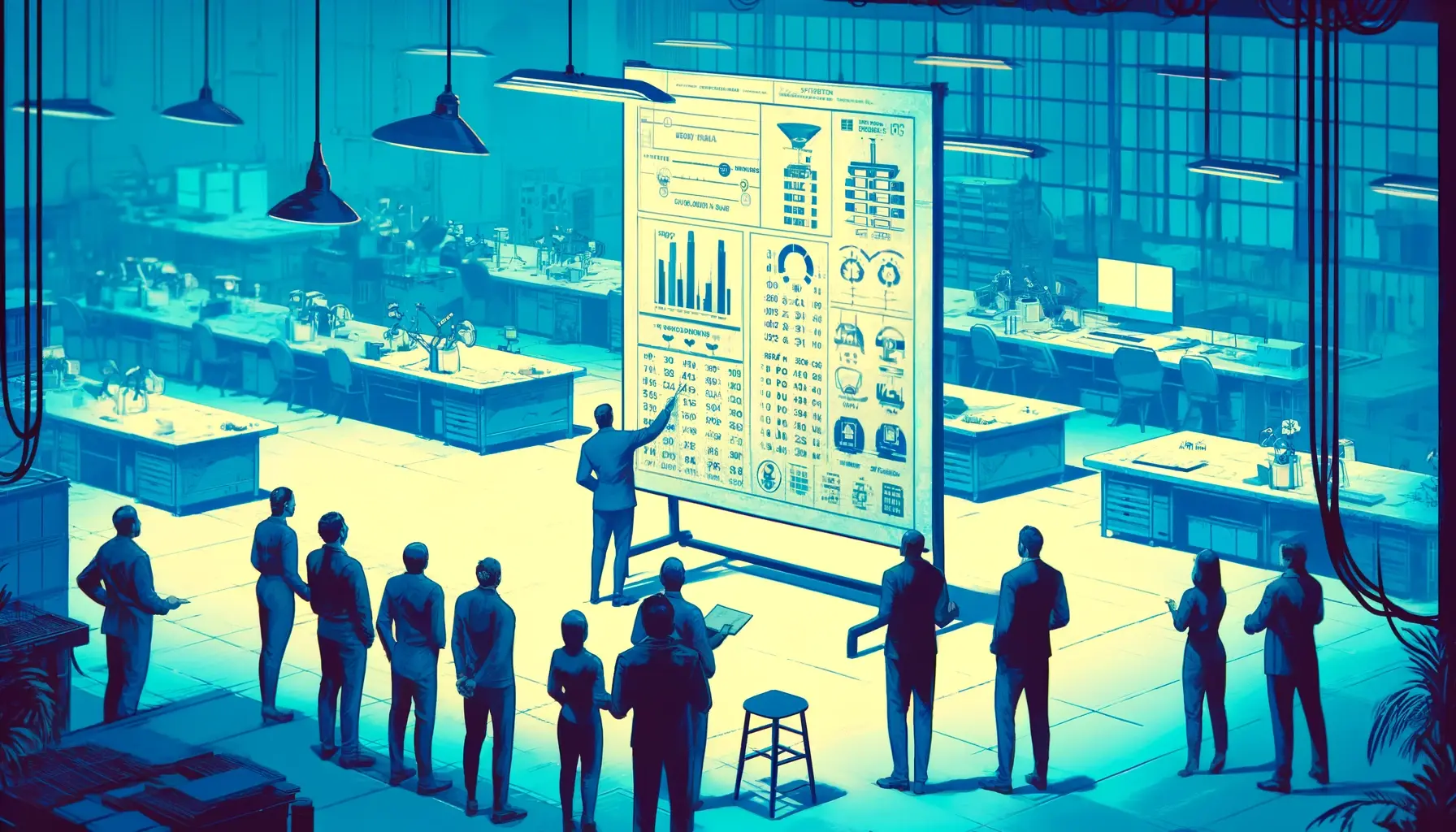
TABLE OF CONTENTS
Summary
Shop Floor Management (SFM) is a leadership framework from Lean Management that aims at permanent improvement of work systems or operational excellence.
Thus, SFM is a significant tool to strengthen competitiveness, save costs and significantly increase resilience of the organization, processes and employees.
Learn more about Shop Floor Management here.
Shop Floor Management is the leadership framework from Lean Management. This can be easily explained with the help of the following figure.
The leadership work takes place in the dialog between the managers and employees to a significant extent in the context of Shop Floor Management meetings in the entire cascade.
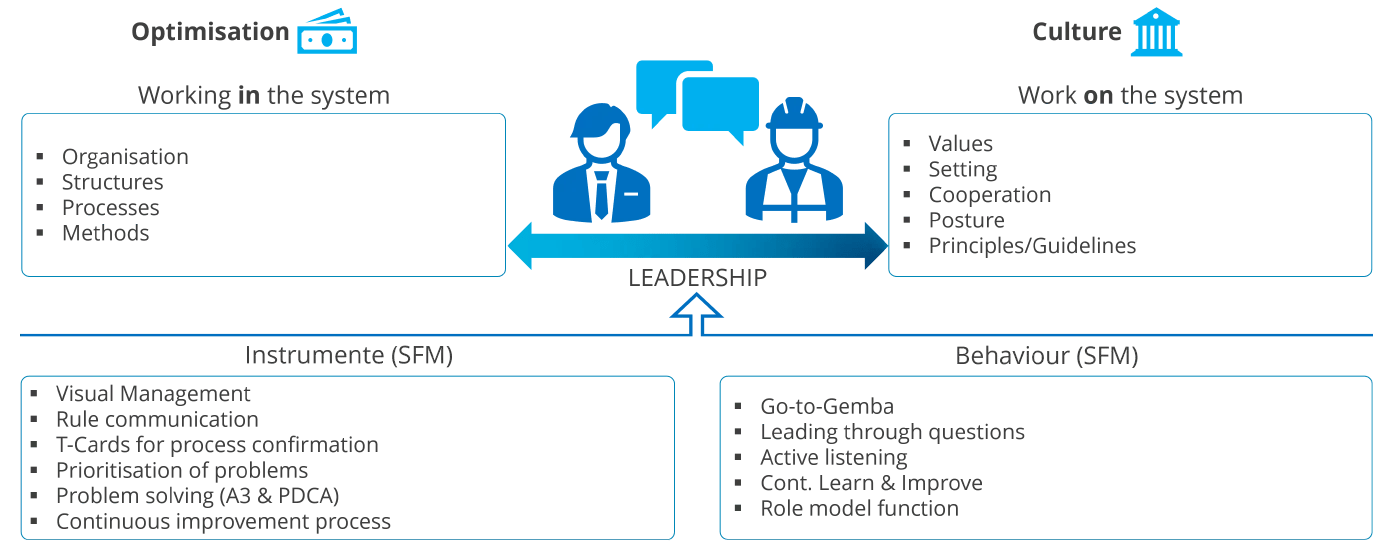
Source: Staufen.ValueStreamer GmbH
At the same time, in the case of difficult problems, for example, the support cascade can be triggered in a process, whereby these issues are escalated, then, for example, the error correction or the problem-solving process can be carried out in the form of a coaching dialog between manager and employee. On the one hand, this leads to learning through insight on the part of the employee and has the consequence that similar problems in the future can be solved at the level where these problems arise. On the other hand, the manager also continues to develop in the context of employee development and leadership with a connection to reality.
The work system is permanently improved through the continuous and consistent "correction of errors" or "problem-solving". When applied consistently, a culture of permanent learning and improvement is created. In "Lean jargon", we talk about the avoidance of waste (muda).
In order to support a work system in such a leadership framework as Shop Floor Management, leadership tools are needed, such as:
At the same time, there is also a need for some soft skills for leadership that contribute to culture development as a consequence of leadership actions, such as:
Shop Floor Management was developed in Japan in the 1950s and 1960s and became known in particular in connection with the Toyota Production System (TPS).
TPS - from which Lean Management was derived in the Western world (Womack & Jones) - is a philosophy and methodology aimed at improving the efficiency and quality of processes (so far primarily in production processes).
It is based on the following principles:
Following these principles consistently in a work system leads to continuous improvement (kaizen) and the elimination of waste (muda).
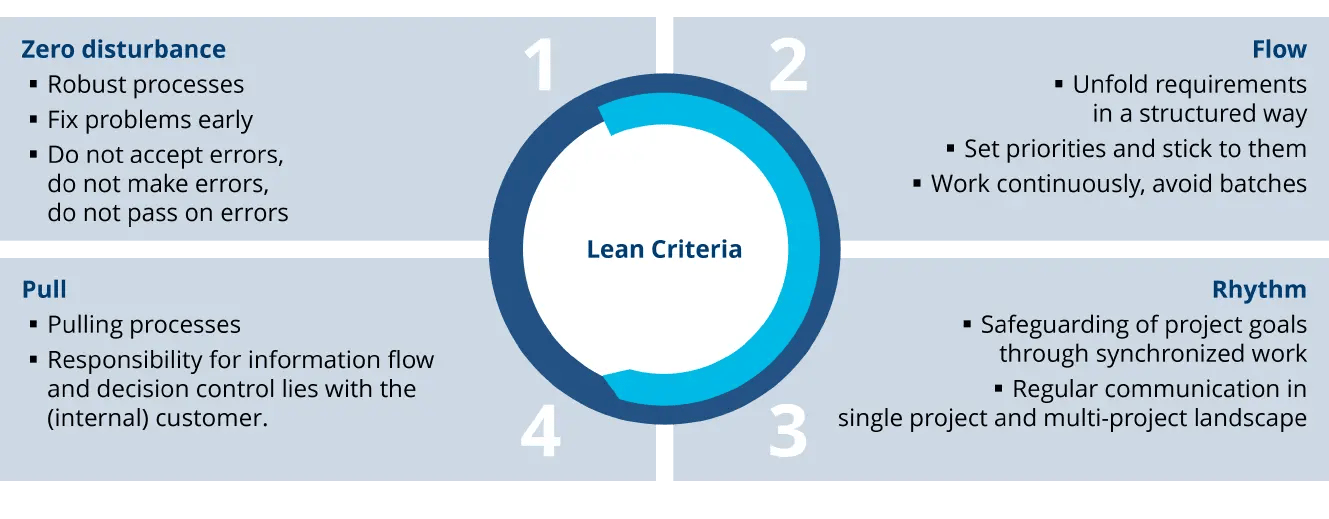
Source: Staufen AG
Shop Floor Management is part of this philosophy and its application to date has focused on the operational level of production, the so-called "Shop Floor". By integrating the employees on site, the aim is to actively involve the direct observers of the production process in process improvement. By encouraging them to identify problems, develop solutions and implement improvements, a culture of continuous improvement, self-responsiblity and self-control is fostered.
Thus, in most applications to date, store floor management has been limited mainly to use in production. However, it also offers very broad application possibilities in the indirect functional areas and unfolds immense improvement potential there.
As already mentioned, Shop Floor Management has so far been limited in most applications mainly to use in production. However, it also offers very broad application possibilities in the indirect functional areas and unfolds immense improvement potential there.
Shop Floor Management has spread around the world over the years and is used not only in manufacturing companies, but also in other industries and many other business functions to improve performance and efficiency and foster a culture of continuous improvement.
This also shows how important Shop Floor Management is for competitiveness, resilience and reliability in value networks.
Ultimately, SFM pursues the goal of achieving operational excellence and thus supports and promotes the Lean Management philosophy.
Therefore, from our point of view, SFM with lived Lean Management is the basis and basic prerequisite for the further steps of work system optimization, such as:
Because SFM is consistently geared to working on the permanent improvement (performance improvement) of a work system in the direction of operational excellence, e.g. by:
The benefit from the implementation of SFM results from the raised and mostly P&L effective improvement potentials through:
If one considers a balance of the effects of SFM in terms of advantages and disadvantages, the following approaches result:
With analog SFM (paper-based), the methodology reaches its limits if it is to be used to manage cross-site processes and work systems. On the other hand, however, this can be countered very well by digital tools. That means, tools needed for the implementing the method successfully become digital.
With digital Shop Floor Management, SFM meetings takes place virtually, by connecting distributed locations. Transparency is available in real time worldwide.
Analog Shop Floor Management requires a relatively high manual effort for data preparation, aggregation and provision to the Shop Floor Management Boards.
An empirical value for this: a work system with approx. 150 to 200 employees requires approx. 1,400 hours per year for manual data preparation.
The time investment, especially in the initial phase of method application, is high to very high for managers in context with mentoring and coaching employees. However, this investment pays off quickly if applied consistently, as the employees who are sustainably qualified through mentoring can very positively influence the robustness and resilience of a system in their work environments (teams, processes, etc.).
SFM is based on four essential pillars:
Below we take a closer look at these components:
Leadership in Shop Floor Management requires the physical presence of executives (leading at the point of value creation). A particular leadership approach from Lean Management has proven to be particularly effective here. Within Shop Floor Management, leaders must observe three main concepts:
These terms conceal the basic idea of Shop Floor Management - that managers should be directly on the scene, often known as the "Gemba Walk". In this context, it is important that the management takes on the role of a mentor and leader, and does not lead authoritatively though orders.
Hansei describes a positive error culture, e.g. errors are seen as an opportunity to learn, improve and develop and not as a weakness.
This involves the setting of corporate goals. These goals are derived by the management level from the corporate vision and broken down to various departments and projects.
The approach includes three aspects:
Another important component is effective communication, especially between managers and employees. Effective communication can prevent misunderstandings and increase employee motivation.
Increasing productivity requires effective measurement of key performance indicators. Here, it is important to find a good balance between too many and too few KPIs. KPIs should not confuse employees but should be clear and understandable.
To solve (recurring) problems in a sustainably, they need to be addressed in a structured way. W. E. Deming's PDCA cycle is recommended here, which comprises the steps of planning (Plan), implementing (Do), checking (Check) and acting (Act).
This not only promotes the continuous improvement process (CIP), but also increases the problem-solving competence of the employees.
Shop Floor Management involves regular discussions (recurring communications/ Shop Floor Management meetings) across the entire management cascade. In these meetings, the current key performance indicators (KPIs) relating to the processes and functions are discussed and deviations are subject to troubleshooting or systematic problem-solving.
It should be noted that the KPIs used can be directly influenced by the teams. For example, it makes no sense to track a KPI for EBIT on the board of an assembly team.
In the start-up phase of SFM, troubleshooting and problem-solving is usually carried out via targeted interactions between the manager and the employees on the Shop Floor level, e.g. in the context of Gemba Walks. Here, technical topics are specifically outsourced from the recurring communications (ReCo) in order to ensure the efficiency and the tight time frame (approx. 15 - 20 min.) of the ReCo.
During these Gemba Walks, learning situations are created in which managers develop their employees, e.g. in systematic problem-solving or similar - principle of leading through questions. This results in deep and sustainable learning through insight. As a result, employees are increasingly able to independently apply error correction and problem-solving methods.
As a result, a culture of permanent improvement is created at all levels of a cascade. Problems are then increasingly solved independently by the now qualified employees at the levels where these problems arise and require less and less assistance from management.
In addition, the collaboration culture is changing from a delegation cascade (executives at the center) to a support cascade (process(es) at the center).
This is also called the principle of the tilted pyramid or servant leadership. Everyone is now concerned with ensuring that processes run as smoothly and reliably as possible in order to serve the customer or the market optimally.

Source: Staufen AG
Each Shop Floor meeting is part of the recurring communication system in the cascade and is defined in a recurring communication calendar that overlaps as little as possible. Thus, a single Shop Floor meeting is the smallest component of a recurring communication cascade (see figure below). For this purpose, a team usually meets in a so-called "standing-sessions" in front of a Shop Floor Management Board as an instrument for creating transparency.
Recurring communication is defined and characterized by the following criteria:
The structure and procedure of a meeting usually follow fixed rules and a fixed agenda (standard).
The preparation of a meeting is done by all participants approx. 10 - 15 minutes before the meeting by preparing and data processing of the Shop Floor Board with the Shop Floor key figures, deviations, measures, tickets, etc. (this works very simple and decentral with digital tools).
The supervisor or the manager in the respective team takes over the moderation. However, the manager also ensures that there is an appropriate, fully-fledged substitute for potential absences of the manager. Meetings are generally never cancelled.
The recording is taken by the participants, e.g. during the meeting in a digital tool or paper entries (circulating recording responsibility).
However, the agenda also allows scope for more individual topics or deepening in the context of topic outsourcing to a smaller circle via Go&See, feedback agreements (à efficiency).
This means that everyone in the cascade is fully informed, important decisions have been made, and everyone is capable of acting on their day-to-day business.
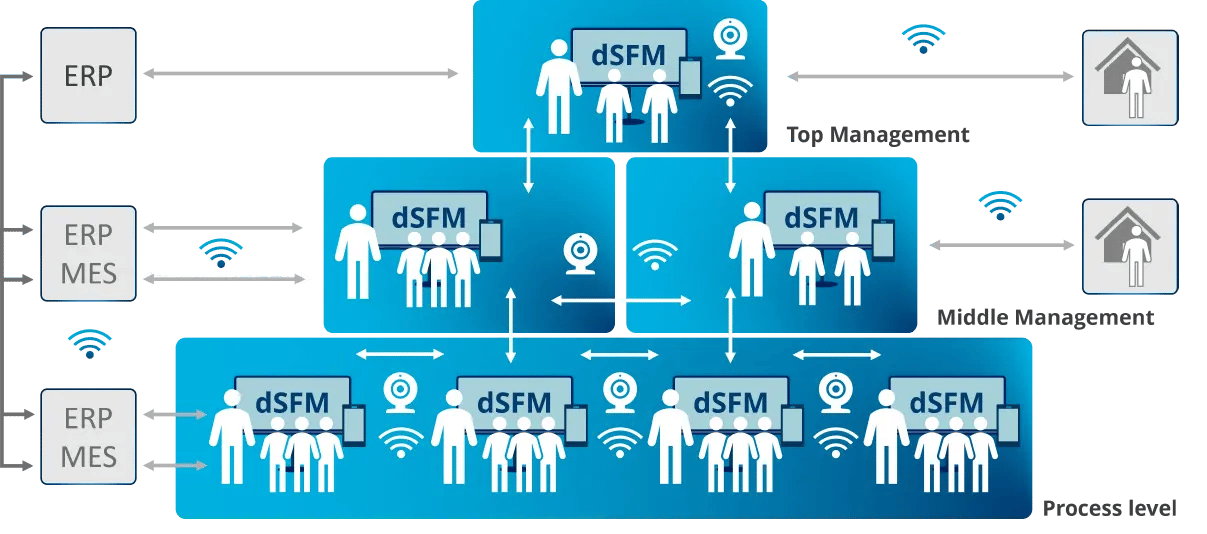 Source: Staufen.ValueStreamer GmbH
Source: Staufen.ValueStreamer GmbH
A functioning Shop Floor Management system can be described in 2 implementation phases and 2 content levels:
In the iceberg model, this is the part above the water. This Phase is short-term oriented and methodological.
In the first phase of the introduction, it is important to implement SFM instruments and thus to achieve visible changes quickly, e.g:
The instrumentalization phase serves as the basic alignment of an organization with the respective processes and functions in the work system to be managed with SFM. In this phase the "organizational learning" starts which is then developed into direction, attitude, behavior, and values through Phase 2.
Note: Many companies mistakenly discontinue further implementation of SFM after Phase 1 because they believe that the essential steps have been made with the tools and methods introduced - principle only what is visible counts. However, this is only about 20% of the way.
This is the under-the-water part - mid-term oriented and the level of skills, attitude and behavior.
In a second phase of SFM implementation, the focus is on developing skills, attitudes, and behaviors through training, coaching and mentoring that are conducive to the practice of continuous improvement.
This is where about 80% of the effort in SFM implementation is, and at the same time, 80% of the impact of SFM. It includes the more long-term, lower visibility activities in the form of developing behaviors, values, and culture elements such as:
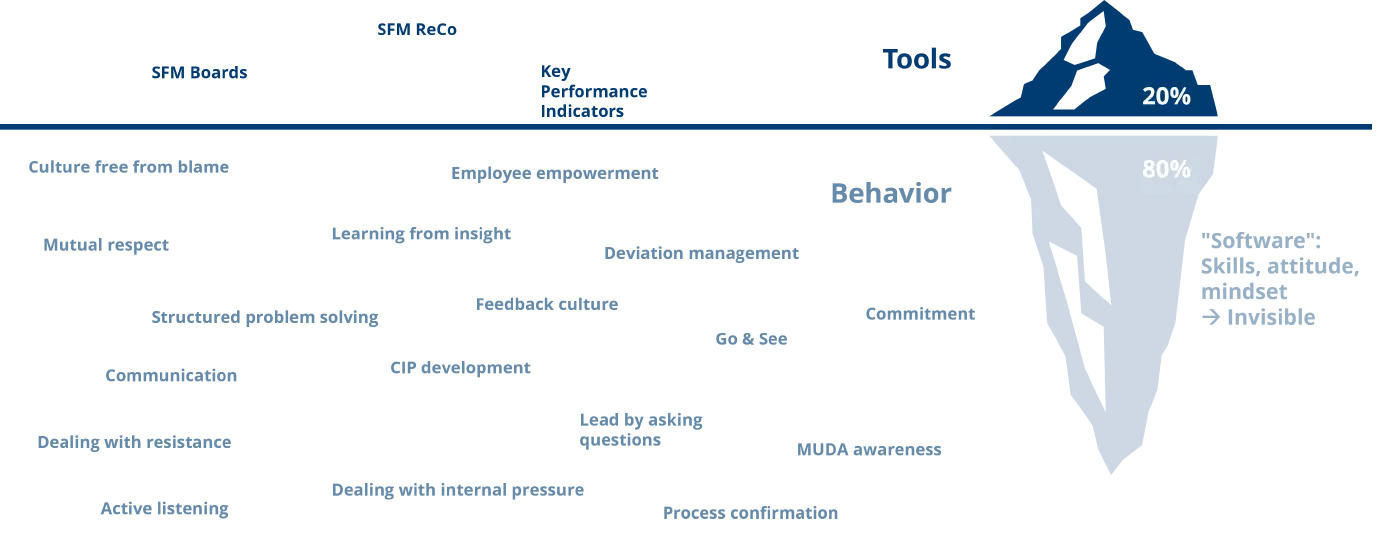
Source: Staufen AG
In the second phase, the involvement of an external feedback provider is absolutely necessary. Here, an external trainer, consultant, coach must
At the end of a successful implementation process, a code of attitude/behavior emerges through which employees and managers are intrinsically driven to advance a work system of permanent and continuous improvement towards Operational Excellence (OPEX).
Contact us for more information.

Let’s face it, the past few years have been a crash course in supply chain fragility. If you’re a CEO or senior manager in manufacturing, you've...
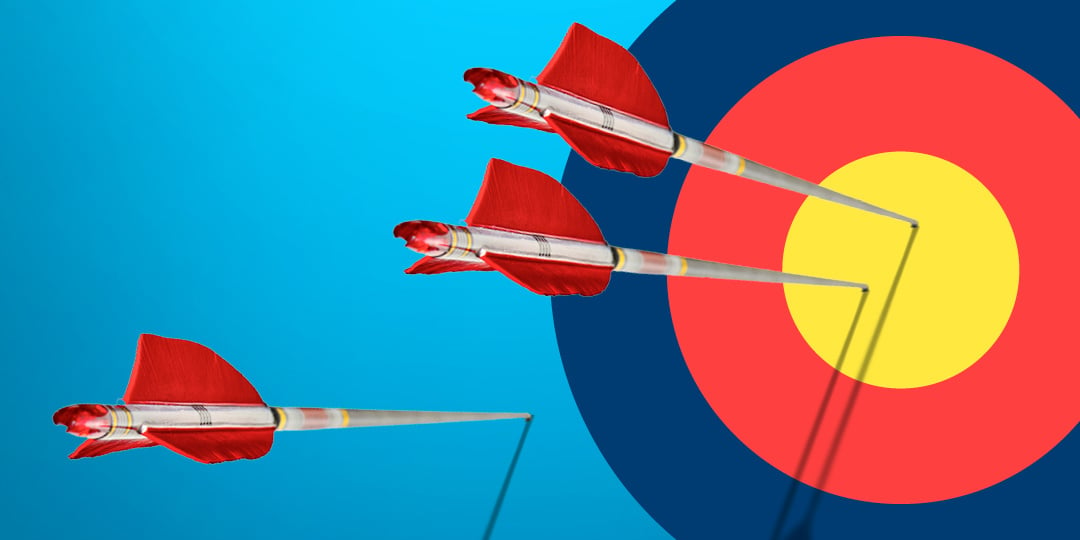
What’s Going Wrong, and What You Can Do About It If you manage a mid-level manufacturing company, you know the pressure of meeting yearly goals. But...

When we think of Halloween, images of haunted houses, spooky masks and eerie fog may come to mind. But what if we told you that these elements are...

Is lean management still up to date? We've been hearing more and more lately: Lean is over! We have been in the age of beyond lean for a long time!

The 10 Main challenges The introduction of lean management can encounter a variety of challenges, both cultural and operational.